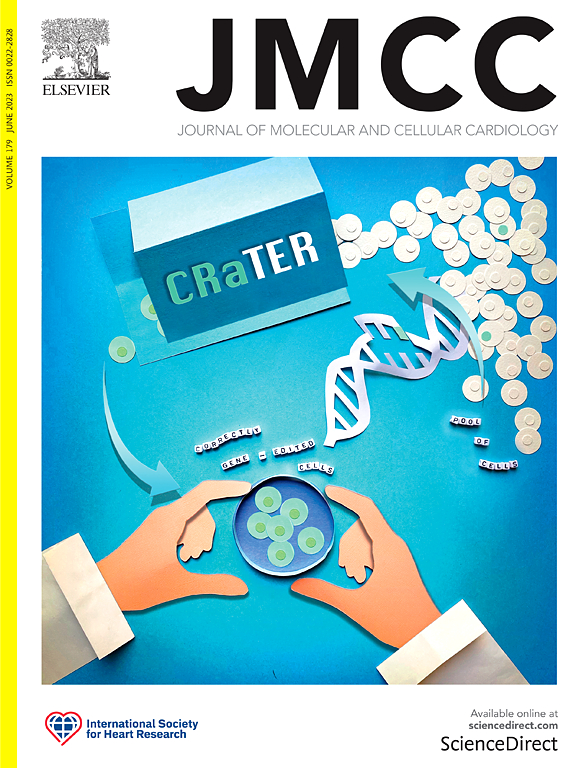The role of the troponin T interactions with actin in regulation of cardiac thin filament revealed by the troponin T pathogenic variant Ile79Asn
IF 4.7
2区 医学
Q1 CARDIAC & CARDIOVASCULAR SYSTEMS
引用次数: 0
Abstract
Cardiac muscle contraction/relaxation cycle depends on the rising and falling Ca2+ levels in sarcomeres that control the extent of interactions between myosin-based thick and actin-based thin filaments. Cardiac thin filament (cTF) consists of actin, tropomyosin (Tm) that regulates myosin binding to actin, and troponin complex that governs Tm position upon Ca2+-binding. Troponin has three subunits – Ca2+-binding troponin C (TnC), Tm stabilizing troponin T (TnT), and inhibitory troponin I (TnI). TnT N-terminus (TnT1) interactions with actin stabilize the inhibited state of cTF. TnC, TnI, and Tm work in concert to control actomyosin interactions. Cryo-electron microscopy (cryo-EM) provided factual structures of healthy cTF, but structures of cTF carrying missense mutations linked to human cardiomyopathy are unknown. Variant Ile79Asn in human cardiac TnT (TnT-I79N) increases myofilament Ca2+ sensitivity and slows cross-bridge kinetics, leading to severe hypertrophic/restrictive cardiomyopathy. Here, we used TnT-I79N mutation as a tool to examine the role of TnT1 in the complex mechanism of cTF regulation. Comparison of the cryo-EM structures of murine wild type and TnT-I79N native cTFs at systolic Ca2+ levels (pCa = 5.8) demonstrates that TnT-I79N causes 1) dissociation of the TnT1 loop from its actin interface that results in Tm release to a more activated position, 2) reduced interaction of TnI C-terminus with actin-Tm, and 3) increased frequency of Ca2+-bound regulatory units. Our data indicate that the TnT1 loop is a crucial element of the allosteric regulatory network that couples Tn subunits and Tm to maintain adequate cTF response to physiological Ca2+ levels during a heartbeat.

肌钙蛋白T致病变异Ile79Asn揭示的肌钙蛋白T与肌动蛋白相互作用在心脏细丝调控中的作用
心肌收缩/松弛周期依赖于肌节中Ca2+水平的上升和下降,控制肌球蛋白基粗丝和肌动蛋白基细丝之间相互作用的程度。心肌细丝(cTF)由肌动蛋白、调节肌动蛋白与肌动蛋白结合的原肌球蛋白(Tm)和控制Ca2+结合时Tm位置的肌钙蛋白复合物组成。肌钙蛋白有三个亚基——钙结合肌钙蛋白C (TnC)、稳定肌钙蛋白T (TnT)和抑制肌钙蛋白I (TnI)。TnT n端(TnT1)与肌动蛋白的相互作用稳定了cTF的抑制状态。TnC、TnI和Tm协同作用,控制肌动球蛋白的相互作用。冷冻电子显微镜(cryo-EM)提供了健康cTF的真实结构,但携带与人类心肌病相关的错义突变的cTF结构尚不清楚。人类心脏TnT (TnT- i79n)变异Ile79Asn增加肌丝Ca2+敏感性,减缓过桥动力学,导致严重的肥厚/限制性心肌病。在这里,我们使用TnT-I79N突变作为工具来研究TnT1在cTF调节的复杂机制中的作用。在收缩期Ca2+水平(pCa = 5.8)下,比较野生型和天然cTFs的冷冻电镜结构表明,TnT-I79N导致1)TnT1环从其肌动蛋白界面分离,导致Tm释放到更活化的位置,2)减少TnI c端与actin-Tm的相互作用,3)增加Ca2+结合的调节单元的频率。我们的数据表明,TnT1环是变构调节网络的一个关键元素,该网络将Tn亚基和Tm偶联,以维持心跳期间cTF对生理Ca2+水平的足够反应。
本文章由计算机程序翻译,如有差异,请以英文原文为准。
求助全文
约1分钟内获得全文
求助全文
来源期刊
CiteScore
10.70
自引率
0.00%
发文量
171
审稿时长
42 days
期刊介绍:
The Journal of Molecular and Cellular Cardiology publishes work advancing knowledge of the mechanisms responsible for both normal and diseased cardiovascular function. To this end papers are published in all relevant areas. These include (but are not limited to): structural biology; genetics; proteomics; morphology; stem cells; molecular biology; metabolism; biophysics; bioengineering; computational modeling and systems analysis; electrophysiology; pharmacology and physiology. Papers are encouraged with both basic and translational approaches. The journal is directed not only to basic scientists but also to clinical cardiologists who wish to follow the rapidly advancing frontiers of basic knowledge of the heart and circulation.

 求助内容:
求助内容: 应助结果提醒方式:
应助结果提醒方式:


